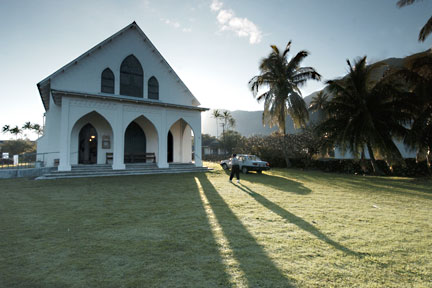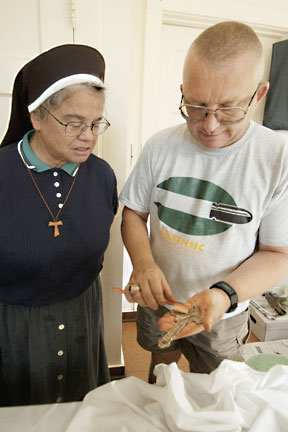
|
View from
the Pew |
THE PATH TO SAINTHOOD
Speaking to a Honolulu congregation

|
1 star helps others shine
|
Power of a PortraitHonolulu artist Peggy Chun painted the portrait of Mother Marianne Cope that hangs in St. Francis Medical Center. It has been used in the logo in Star-Bulletin stories about Cope."It is the last detailed painting she did after being diagnosed with ALS," said her daughter-in-law Kimi Chun. Amyotrophic lateral sclerosis, also called Lou Gehrig's disease, causes degeneration of nerves and muscles. Peggy Chun has a reproduction of the portrait hanging over her bed. "She felt the spirit of Mother Marianne; she is very special to her," Kimi Chun said. "She prays for her help."
|
Mother Marianne Cope's story is a full one, so journalists tend to sum it up as her 30 years of care for Kalaupapa residents, answering the call from King Kalakaua, who sought help in the epidemic. There are books on sale with the full story, but here is a peek or two.
» Look at the old photographs of Kalaupapa and you see young women in bright muumuus and hats, men working or dressed up for church, children in orderly lines in a classroom. They had shelter and food, were taught sewing or carpentry, the chance to build their own homes, not to mention their self-esteem. They made friends and they got married. The chaotic first years when patients were pitiful and outcast in the 19th century leprosy epidemic, cast into the rough without shelter, preyed on by bullies -- all that was turned into an orderly society, and Cope and Father Damien DeVeuster get a lot of the credit for that.
The galaxy that is Kalaupapa has had countless other stars in it: Protestant ministers just as dedicated to their flocks, government officials who met the challenge of that less-than-choice assignment, disease-free relatives and friends who came as "kokuas" for people they loved, doctors and nurses who brought equal parts of kindness and professionalism, and patients whose love, humor, empathy, pride and patience with each other made a human community out of a life they didn't choose. Not all of those unidentified saints are dead.
» Read about a professional woman hitting a peak after 20 years of experience and growth, making decisions that affected hundreds, expanding the business and gaining great respect. That was the Syracuse hospital administrator, a key player in the creation of the first public hospital in that town in upstate New York, which generated such a reputation for teaching medical interns that a medical college was built there. And a woman did all this in the 19th-century man's world. No way would someone walk away from that heady career.
But a hint of her future was there as she insisted that outcasts of the time, drunks and prostitutes, be treated at St. Joseph's Hospital. In her pioneer version of patients' rights, doctors were not to bring medical students for a case lecture around the bedside without the consent of the person in the bed.
» When Cope led her sisters to the unpredictable assignment in Hawaii, she planned to return to the safe and satisfying life in Syracuse. Why did she stay? That's what's hard to capture in a newspaper story. That's the real answer to the cranky caller's question. That's the reason she is on the way to being declared a saint by the Catholic Church.
"She had the immense desire to follow the Lord," said Sister Grace Anne Dillingschneider, a leader of the 21st Century Sisters of St. Francis.
Cope wrote hundreds of personal letters and Sister Mary Laurence Hanley of Syracuse began collecting them about 25 years ago. Hanley has headed the cause for sainthood ever since. Cope wrote about God, his love, her prayers in her personal messages. "God was always on her mind," Hanley said.
"We all personalize our view of Mother Marianne," said Sister Marion Kikukawa, co-postulator of the sainthood cause.
"She said, 'I do not fear any disease,'" Kikukawa recalled at a Sunday night service in Kalaupapa. "She was saying that she trusted in God. She persevered, she gave her life to God. Her story, her life, her inspiration, her virtue will always be part of this place."
Kikukawa said she uses Cope's words with her own spin. "I say that I do not fear any dis-ease, the uneasiness when we have to do something that makes us unsettled."
"She was humble," said Sister Patricia Burkhard, general minister of the religious order. "The church wants to recognize ordinary people doing very good things. The idea is not that saints were so grand, held in such high esteem that sainthood is unreachable for us."
The "one thing saints have in common is their faithfulness to God," a Honolulu congregation was told Thursday. The Rev. Paul Zaccone was talking about a different saint, a woman who dared to promote education for young women. In 16th-century Italy, that was courage.
"Not all saints are recognized. Most of their names are never known to us," Zaccone said. "I expect there are saints here among us today."
My advice to the cranky caller is to take that as her answer. Forget "all the fuss" about this one star who has been recognized. There are a lot of bright lights out there. No telescope is required to find them. No church process is needed to recognize them. We can all do it.
Ceremony and Mass
will mark sendoff for
Mother Marianne
A Monday afternoon ceremony in Honolulu will be the finale of Hawaii events honoring Mother Marianne Cope, who served leprosy patients in Kalaupapa for 30 years until her death in 1918.The remains of the Franciscan nun will lie in state at Our Lady of Peace Cathedral on Fort Street mall after 3 p.m. The bones will not be on view; they will be sealed in a zinc box.
The Rev. Thomas Gross, administrator of the Catholic diocese, will preside at a 5 p.m. Mass.
Cope's bones were exhumed from her grave in Kalaupapa earlier this week. They will be taken to Syracuse, N.Y., to the headquarters of the Sisters of St. Francis where a shrine will be built to memorialize her.

Sister Frances Therese Souza watches archaeologist Vincent Sava brush away some debris from a cross that was found directly behind the skull of Mother Marianne Cope.
"We are retracing her path in reverse," said Sister Grace Anne Dillingschneider, a leader of the religious community, which has about 500 members. Most of the 50 Franciscans in Hawaii are expected at the Manoa convent for a candlelight service tonight and a Mass tomorrow morning. Both events are private.
The cathedral was the first stop for Cope and the six nuns she brought to Hawaii in 1883 after their arrival at Honolulu harbor. They attended Mass and were greeted by leaders of the church and the Kingdom of Hawaii.
The remains will be taken to a Syracuse cathedral Tuesday, then to the Franciscan convent on the site where Cope lived.
The public welcome for Cope will be held in Assumption Church in Syracuse, where she first took her vows of poverty, chastity and obedience and began her life as a Franciscan.
![]()
[News] [Business] [Features] [Sports] [Editorial] [Do It Electric!]
[Classified Ads] [Search] [Subscribe] [Info] [Letter to Editor]
[Feedback]
